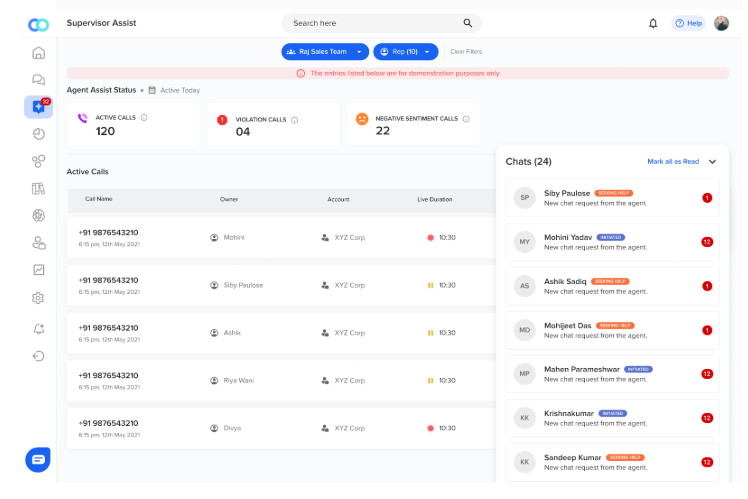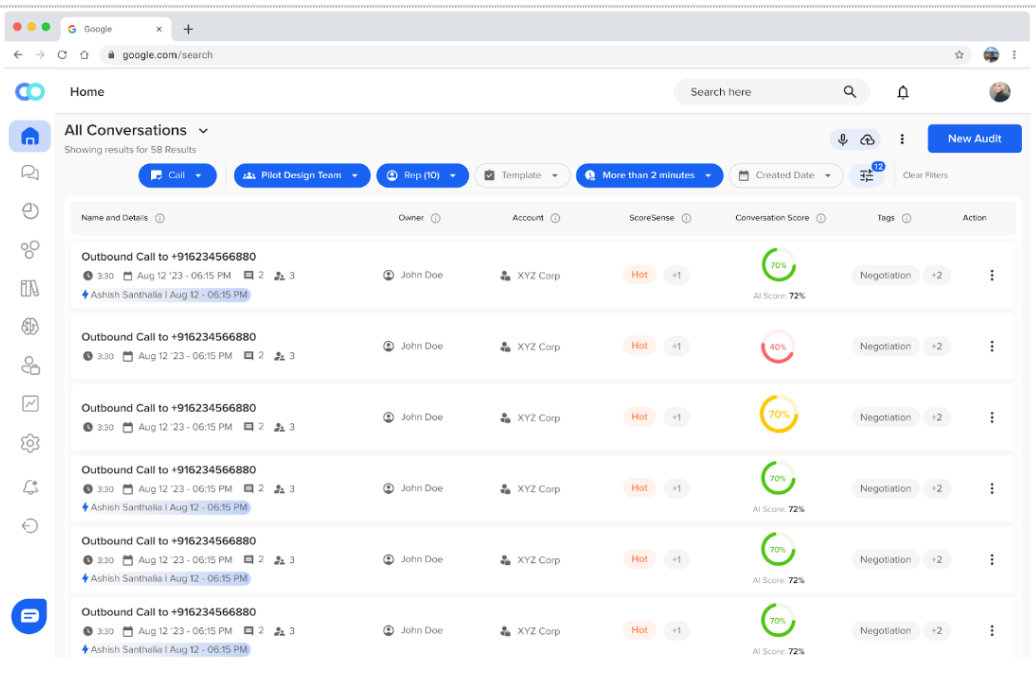The insurance industry is standing at the edge of a major operational shift, one driven by generative AI. As customer expectations rise, regulations tighten, and operational costs balloon, insurers can no longer afford to rely on legacy systems and slow workflows.
Carriers that embrace AI won’t just survive the next decade, they’ll lead it. But how exactly is generative AI in insurance moving from hype to hard ROI?
In this blog, we break down the current state of generative AI in insurance, where carriers are applying it today, what full transformation will look like, and how leaders are using it to stay compliant, cut costs, and elevate customer experience.
From touchless claims to real-time agent guidance and voice bots that actually understand policyholders, we explore the tools and trends shaping the future.
We also dive into how platforms like Convin are helping carriers operationalize AI at scale. Let’s explore how to future-proof your operations now.
Benchmark your AI adoption against industry peers with Convin
The State Of Generative AI In the Insurance Industry: Now Vs Future
Generative AI is already influencing insurance, but progress varies widely. Some carriers are scaling pilots; others are still exploring. Looking at where insurers are today and where they’re headed reveals the urgency to modernize, the gaps to close, and the opportunities waiting to be seized.
1. Current Adoption In Automation, Voice Bots & Operational AI
Many insurers are beginning to experiment with AI in pockets; underwriting, claims triage, fraud detection, and simple customer bots are common early uses. But deep integration of generative AI remains rare: most carriers haven’t yet pushed beyond pilots into full-scale transformation.
- In a 2025 survey of over 240 insurance executives, underwriting, claims, fraud detection, and customer service were the top AI use cases.
- Many insurers still rely on script‑based chatbots for FAQs or claims status checks.
- AI voice bots are emerging: for example, some platforms now automate up to 80% of routine calls in insurer setups.
Still, current bot architectures tend to be rule‑based. They follow predefined scripts and escalate to humans when exceptions arise. The real promise of generative AI, bots that reason, explain, and adapt, is not yet fully realized.
In short, generative AI is present in fragments. Carriers see early wins in speed, cost, and consistency. But the path to full transformation, where AI is woven into decisioning, voice engagements, and orchestration, remains ahead.
2. Predictive Intelligence & Autonomous Decisions
Looking ahead, insurers are working to shift from narrow AI tasks to holistic, generative systems that can drive decisions and interactions autonomously.
Generative AI will power touchless underwriting and claims, making many decisions without human review. This opens the possibility of instant policy issuance and claim resolution.
Voice agents, too, will evolve. They’ll hold natural dialogues, detect emotion, adapt their tone, and even upsell or cross‑sell, all while staying compliant with disclosure rules.
Carriers will increasingly adopt “anticipatory service” models, predicting policyholder issues before they arise and intervening proactively.
McKinsey argues that generative AI brings more than incremental gains: it has the potential to rewire operations across underwriting, claims, service, and back office rather than just layering on tools.
In that future, AI isn’t a supporting role. It becomes the brain behind operations, decision-making, and customer engagement, with humans as strategic overseers.
Generative AI is gaining traction, but the maturity gap between exploration and execution is growing. Understanding this divide is key to recognizing what’s truly transformative.
Move beyond AI pilots to full-scale transformation with Convin
Insurance Automation: Evolving Workflows For Faster Outcomes
Automation already drives efficiency in insurance. But generative AI promises a new level: workflows that self-optimize, self-learn, and adapt. Let’s explore how it's advancing workflows.
1. The Bottlenecks Slowing Automation In Insurance
Our current automation efforts often run into silos: underwriting, claims, and servicing tend to operate in separate domains. Many steps still rely on human judgment or manual data gathering, especially when exceptions appear or context shifts.
Traditional automation tools, like RPA, manage rule‑based tasks well, including invoice routing, approvals, and simple data pulls. But whenever something doesn’t align exactly with the rules set, a human must intervene and correct mistakes.
A 2025 whitepaper, State of Automation in Insurance, cautions that legacy automation is nearing its ceiling; it can no longer scale with complexity.
Meanwhile, nearly 68% of insurers are reported to be migrating to cloud platforms, a move intended to enable more agile, AI‑driven workflows.
So while automation today cuts down repetitive work, judgment calls, exception handling, and orchestration still depend heavily on humans.
2. AI-Powered Workflows That Accelerate Underwriting & Claims
Generative AI is unlocking the next phase of automation, intelligent, adaptive, and real-time.
Underwriting engines will take in diverse inputs, text, images, and sensor data, and output full policy decisions with narrative justifications. The system explains why it accepted or declined.
In claims, bots will self‑triage: parsing damage reports, scheduling inspections, and issuing payouts, all without human handoffs.
In one academic study, an LLM applied in an insurer’s environment improved throughput and scalability when automating claim segmentation.
At that level, human intervention shrinks. Oversight or exception review remains, but the bulk of decisions and execution will happen autonomously.
Automation is no longer just about reducing manual work. AI is redefining workflows end-to-end, making processes faster, smarter, and more adaptable.
Automate underwriting and claims with Convin’s LLMs
This blog is just the start.
Unlock the power of Convin’s AI with a live demo.

Meeting Regulatory Demands With AI In Insurance
As AI takes on a core operational role, regulators are quickly establishing oversight frameworks. For insurers, the challenge is to innovate at speed while maintaining airtight compliance, a balance that demands embedded governance from the ground up.
1. Navigating Evolving AI Regulations In The U.S.
As state regulators intensify scrutiny around AI, insurers must evolve their governance models to remain compliant and agile.
By March 2025, 24 U.S. states had adopted the NAIC Model Bulletin addressing insurers’ use of AI systems.
Under this Model Bulletin, insurers must implement a written AI program, establish governance and internal controls, oversee vendors, and provide consumer notice about AI usage. (source)
Meanwhile, states like New York layer additional regulation; for example, the NY DFS Circular restricts how AI can be used in underwriting and pricing decisions.
At present, compliance is heavy, manual, and fragmented. Many insurers struggle to align AI models with existing legal frameworks, resulting in reactive oversight rather than proactive governance.
2. Building Real-Time Compliance Into AI Systems
To meet rising regulatory expectations, insurers must shift from manual oversight to embedded, real-time compliance. This means building systems that monitor themselves continuously and flag issues before they escalate.
Modern AI governance will rely on production-grade tools, dashboards, real-time alerts, and audit trails, all integrated into live workflows.
Models will self-audit, constantly testing for fairness, accuracy, and drift. These systems won’t just react to audits; they’ll anticipate regulatory scrutiny and document compliance as part of day-to-day operations.
Looking ahead, regulators may mandate the use of explainable AI interfaces, transparent decision logs, and embedded compliance logic, making AI decisions visible and verifiable.
In that world, compliance is no longer a department. It’s part of the software, baked into every model, process, and output. Accountability becomes systemic.
As AI adoption deepens, compliance is under the microscope. Insurers must shift from reactive governance to embedded, intelligent oversight.
Stay compliant with Convin's AI fraud detection
Revolutionizing Customer Communication In Insurance
Customer expectations have evolved; speed, personalization, and convenience are now baseline. To meet them, carriers must go beyond digital channels and fundamentally rewire how they communicate.
1. Where Traditional Communication Channels Fall Short
Even with growing investment in chat and voice channels, most insurer communications remain reactive and rigid.
Many carriers rely on chatbots strictly for basic FAQ resolution, policy lookups, billing inquiries, or claims status updates, and avoid more complex conversational tasks.
Similarly, voice bots today are limited to menu navigation or simple queries. When topics get complex, say, policy changes, disputes, or nuanced claims questions, the interaction is escalated to a human agent.
Meanwhile, call scripts remain fixed. Personalization rarely goes beyond inserting a customer name or policy reference. There’s little adaptation in tone, context, or path logic.
The result: calls feel rigid, throughput is slow, and agents spend considerable time “rescuing” conversations that bots couldn’t handle.
2. How AI Voice Bots Enable Human-Like, Compliant Conversations
AI voice agents are changing how insurers interact with policyholders, and we’re only seeing the beginning of that shift.
Voice bots are becoming capable of handling questions on claims, policy changes, renewals, even upselling, all in a conversational, compliance-aware style. Such systems manage disclosures, routing, and context without rigid scripts.
Some platforms already report automating 60–80% of routine calls in insurance environments.
These bots don’t simply respond; they monitor compliance in real time, checking limits, verifying disclosures, flagging exceptions, and forwarding only nonstandard cases to human agents.
Moreover, generative AI can generate email or SMS transcripts from that voice interaction, helping insurers close the loop across communication channels.
The direction is clear: communication will become seamless, humanlike, always on, and deeply integrated.
Customers want fast, personal, and frictionless support. Generative AI is stepping in to deliver conversations that feel both human and compliant.
Switch to compliant, human-like voice bots with Convin
Real Transformation With Convin: Driving Compliance, Speed & Experience
Convin delivers production-ready generative AI tools built specifically for insurers, not experiments, but operational systems designed to drive real transformation across compliance, communication, and claims.

1. Real-Time Agent Assist: Boosting Accuracy And Compliance
Convin’s real-time agent assist empowers insurance agents during live calls by offering real-time prompts, compliance alerts, and contextual guidance, all without disrupting the conversation flow.
The tool listens to ongoing calls, analyzes speech in real time, and pushes dynamic suggestions like mandatory disclosures, policy details, or rebuttals exactly when needed.
Key features include:
- Real-time prompts for next-best actions and compliance steps
- Instant access to knowledge base, scripts, and visual checklists
- Proactive alerts for missed disclosures or off-script moments
- Supervisor dashboards to monitor and coach in real time
Results delivered:
- 21% boost in sales, 27% rise in CSAT, and 25% faster issue resolution (Source)
By combining guidance and automation, it bridges human expertise with AI precision, helping agents stay sharp, accurate, and fully compliant.
Image 1:
2. Voice Of Customer: Unlocking Hidden Insights
Convin’s voice of customer (VoC) solution turns raw feedback into powerful insight, helping insurers deeply understand how policyholders feel and why.
It pulls data from calls, chats, and emails, then uses AI to score sentiment, intent, topics, and emotional cues across every interaction.
These insights feed directly into script adjustments, agent coaching, and even bot conversations, ensuring messaging evolves with real customer needs.
By spotting trends early, insurers can detect pain points, tailor outreach, and prioritize what matters most.
VoC acts as a real-time listening engine, transforming scattered feedback into strategic action that drives loyalty and better decisions.

3. Conversation Intelligence: Scale Training, Flag Risk Early
Convin’s conversation intelligence platform reviews live and recorded calls to flag compliance risks and surface coaching opportunities. It auto‑analyzes millions of minutes, detecting deviations, tone issues, and gaps in mandatory language.
Each interaction is tagged by topic, sentiment, and risk level, giving managers a clear view of where improvements are needed.
These insights help train agents, fine-tune conversational AI, and optimize scripts, creating a continuous loop of quality improvement and compliance at scale.
Tech becomes transformational when it solves real problems. Convin enables insurers to bridge performance gaps with AI-powered tools built for scale.
Upgrade CX with human-like AI voice agents from Convin
Future Outlook: What’s Next For AI In Insurance
Generative AI is no longer a theoretical frontier; it's actively reshaping how insurance carriers operate, communicate, and compete. From streamlining underwriting to real-time compliance and hyper-personalized customer conversations, AI is embedding itself across every layer of the insurance value chain.
Yet, the real differentiator lies in execution. Insurers that move beyond siloed pilots and embrace AI as a core operational layer will be the ones that stay ahead. With tools like Convin’s Real-Time Agent Assist, Voice of Customer, and Conversation Intelligence, that future isn’t just possible; it’s already here.
If you're ready to move from exploration to transformation, then book your Convin AI demo today!
FAQ
- How is generative AI used in the insurance industry?
Generative AI in insurance is used to automate underwriting, triage claims, flag fraud, and personalize customer communication. It enables AI voice bots, real-time decisioning, and dynamic document generation, improving both speed and accuracy across operations.
- How AI is redefining the future of insurance?
AI is reshaping insurance by turning manual, reactive processes into real-time, predictive systems. From touchless claims to compliance-aware voice bots, insurers using generative AI are creating faster, more customer-centric operations, while reducing costs and risks.
- Which is one challenge in insurance fairness in generative AI?
One major challenge is bias in AI decisioning, especially in pricing, underwriting, or claims. Insurers must ensure their generative AI systems are explainable, audited for fairness, and aligned with emerging regulations like the NAIC Model Bulletin.
- What is the role of AI in insurance transformation?
AI plays a central role in insurance transformation by replacing rule-based workflows with intelligent automation. Platforms like Convin help carriers scale compliance, improve CX, and surface actionable insights from every conversation, all in real time.









.avif)